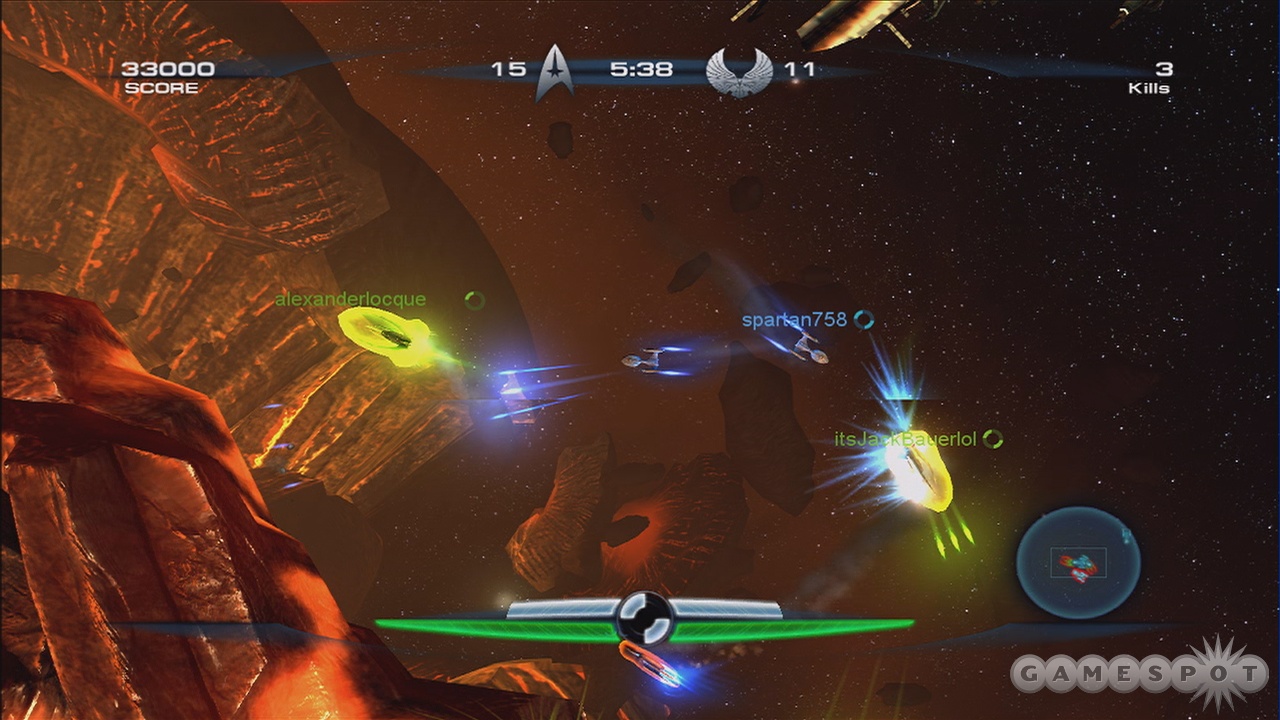There's nothing wrong with simplicity; after all, simple games can be lots of fun, assuming they're amusing enough to sustain your interest. Star Trek: D-A-C is simple--but so simple it's downright primitive, and its one-note gameplay can't compensate for a painfully scant array of features. This multiplayer top-down shooter may feature a famous license, but listening to William Shatner recite his grocery list would be more entertaining. There's a moment or two of fun to be had, but not enough to warrant spending 800 Microsoft points ($10) for them.
Basic gameplay is standard fare for a shoot-'em-up. There are three ships to choose from before you enter a match: fighter, bomber, and flagship. Fighters shoot lasers from the front; bombers drop bombs behind them that explode a moment later; and flagships let you hover a reticle over your target and let loose a blast of energy. The three ships play differently from one another, but they don't offer enough variety for these differences to energize the experience. You'll also pick a side (Federation or Romulan), though aside from the visual design, the ships are exactly the same for both teams. There's no reason to choose one galactic race over the other, and combat is rather ho-hum compared to the enthusiastic action of other 2D shooters. This is partially due to the humdrum visual and sound effects and partially due to floaty controls that get the job done but don't feel as precise as they should. The one spark of originality is that upon defeat, you eject a speedy escape pod that you can control. If you can avoid enemy fire for a few seconds, your ship will spawn back onto the battlefield more quickly than if your pod is also destroyed--and with some power-ups still active.
D-A-C stands for the three modes of play available: Deathmatch (actually, Team Deathmatch; perhaps "T-D-A-C" didn't sound right?), Assault, and Conquest. The quick match option makes it easy to join an online game in progress, though it's far quicker to find a Team Deathmatch game than a Conquest game, and it's almost impossible to find someone playing Assault. That's too bad, because the latter modes are a bit more entertaining than the simple "kill the enemy" action of the former. In Conquest, you take over the map by capturing rings, which keeps the action concentrated on a small number of hot spots. Assault works similarly, only an assaulting team must capture the rings in sequence on its way to the defending team's base, while the defenders must thwart their plans. Both of these modes provide tidbits of fun, particularly when each team fills all six player slots, though the overall lack of energy means the welcome wears off quickly. There's also no context to any of this--no story, no introduction, not even a voice-over telling us to boldly go where no man has gone before. It's just one-off matches, and were it not for the naming conventions and ship designs, you'd never know this was a Star Trek game.
You can join up with friends and play against an all-AI team, but this so-called co-op mode isn't very enjoyable, because the artificial intelligence is easily exploitable, particularly in Conquest mode, where you can rack up kills by camping at the capture rings and picking off bots as they fly in. You can play the same modes offline as well, though the simplistic AI won't be giving you a challenge once you get used to the ships. The greatest challenge comes from other players, but even when playing human opponents, the mild fun is short-lived. A few days after the game's release, the diminishing community indicates that the luster has worn off for many players already, and in too many matches, it's tough to find a full contingent of competitors.
Given the unremarkable, basic nature of the action, you'd expect other elements of the game to pick up the slack. Sadly, there aren't enough features constructed around this scant framework. If you play Team Deathmatch, you'll get to choose from four different maps; Conquest offers only two, while Assault enthusiasts, laughably, get a single map. There is some debris to maneuver around, and the backgrounds are attractive enough, but the maps are similar to one another and don't offer any clever twists that would add some much-needed variety. Power-ups could have also infused the action with energy, but they are a missed opportunity. In the case of ability power-ups, you won't know which enhancement you'll be granted until you pass over the token, though there are only a few possibilities as it is: a temporary shield, a temporary cloak, a temporary clone to fight at your side, a one-use homing rocket, and a one-use energy blast that pushes nearby enemies away. Not only do the options lack creativity, but they don't seem to greatly affect the course of the match. Other types of power-up tokens supplement your health and improve your craft, but their effects aren't dramatic enough either.
After a few matches against the predictable AI and a few ho-hum online skirmishes, you'll be sifting through the menus to see if there's anything more to the game. Alas, the search for Spock was more successful than the quest for lasting value in Star Trek: D-A-C, making it yet another example of a game undeserving of its famed license.
